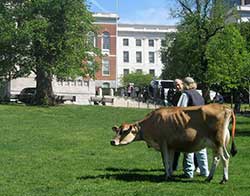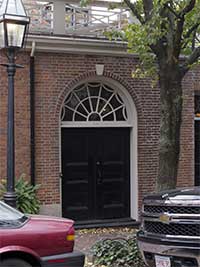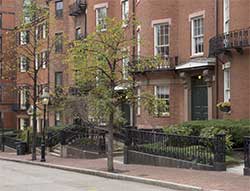Tails of Boston Common.

Today most tails on Boston Common belong to dogs romping in the off-leash areas or squirrels foraging for food. But for our ancestors the most important tails on the Common belonged to livestock, especially cows. In fact much of the early history of America’s oldest public park involves cows on the Common.
Boston’s Back Yard. Common land is just that — everyone can use it even though they don’t own it. The Puritans bought what is now Boston Common in 1634. Initially some settlers wanted to divide it into private plots, however, Governor Winthrop convinced them to keep it for common purposes such as training the militia and grazing cows. Soon it became a public workspace for daily chores ranging from carpet beating to laundry as well as what the strict Puritans considered “lawful recreation.”2
Within a decade the town became concerned that the Common couldn’t feed the number of cows sent there to graze so in 1646 it voted to limit the number to 70. Each person could have one cow or four sheep. Horses were not to graze on the Common except for one belonging to Elder Oliver.
Cows and the Military. From the start cows shared the Common with the local militia. Usually they coexisted peacefully. Occasionally, however, they literally crossed paths, such as when General Humphrey Atherton ran into a cow while riding home in the dark. He was thrown from his horse and suffered fatal head injuries. Some viewed this as Divine retribution since Atherton had a reputation for persecuting Quakers.3

Paths crossed again a century later when British troops camped on the Common during the months leading up to the Revolution. Their presence on the people’s land created friction with the citizenry and apparently at least one cow. Offended by the presence of an occupying army in her pasture this bovine patriot charged right into a stack of British bayonets. Some of the weapons pierced her thick hide and stuck while she ran home carrying valuable armaments to the rebels.
The Common’s cows aided the military again in 1778 when Governor John Hancock was entertaining French officers who had just brought funds for the cash-strapped Continental Army. Hancock’s cook ran out of milk, having underestimated the popularity of his milk punch (due no doubt to the quantity and potency of its non-milk ingedients). No problem, servants were sent across the street to milk cows on the Common.
Legacy. Hancock’s mansion, built by his uncle in the 1730s, was the first grand residence on Beacon Hill, but as things settled down after the Revolution, the Hill became the hot area for residential development. The new, well-heeled inhabitants wanted to use the Common for recreation. As often happens with gentrification, old-time residents got pushed out — cows were banned from the Common in 1830.

But their legacy survives. For example, the deed for property at 50, 56 and 60 Mount Vernon Street requires maintenance of a passageway wide enough for a cow to go from the street to the back alley (photo above). And on Joy Street deeds for four parcels require buildings to be set back 15 feet from the street. That restriction was inserted so the original seller, who owned the land at the top of the street, would retain an unobstructed view of his grazing cows.4 Finally, in 1956 the Harvard Crimson reported discovery on Park Street of underground stalls with a tunnel leading to the Common. It seems the lucky cows who lived there didn’t even have to hassle street traffic when they went to graze.5
-----
- Suzanne (the cow) grazing on Boston Common on May 10, 2010 to protest legislation banning sale of raw milk. Image from FarmAid web site.
- David Hackett Fischer, Boston Common, from American Places: Encounters with History, William Edward Leuchtenburg (editor) Oxford University Press (2000).
- See Wikipeda.
- George Weston, Boston Ways, Beacon Press, Boston (3d ed.) (1974), pp. 30, 38.
- Jonathan Beecher, Cow-Tunnels, Harvard Crimson, April 14, 1956.
This article originally appeared in our free semi-monthly newsletter. To receive future issues, please add your name to the subscription list.

